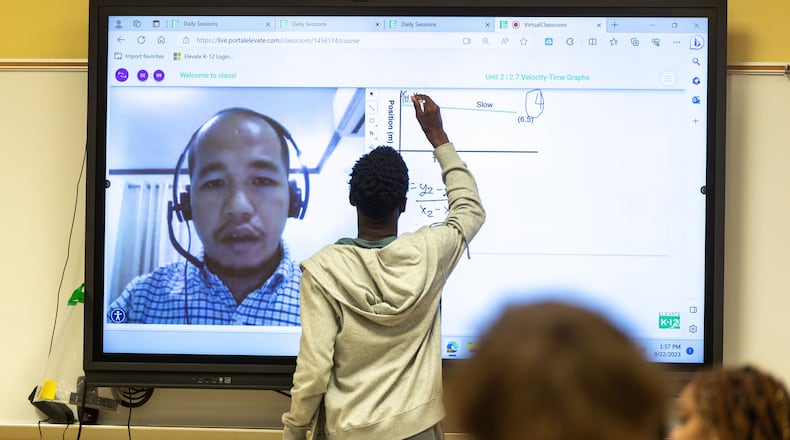Two years after a plunge in the stock market dropped the value of Georgia’s massive teacher, university and state employee pension systems by $15 billion they have made a strong comeback.
That, in turn, has likely helped quiet calls at the Capitol for major changes to the plans, at least for now.
The Teachers Retirement System ended fiscal 2024 on June 30 with a record $105.8 billion in assets.
The Georgia teacher and state employee systems, which provide monthly benefits to more than 200,000 retirees and their beneficiaries, have more than made up the money they lost on paper when the stock market tanked in fiscal 2022.
In the state fiscal year that ended June 30, the TRS and the Employees’ Retirement System, which covers retired state workers, saw 14.5% and 14% returns on their investments, respectively. Their performances were similar to the benchmark Dow Jones Industrial Average during that period.
The market fell hard at the end of last week, but the Dow was still ahead of where it was a month earlier.
The finances of the two funds are closely watched because hundreds of thousands of teachers, professors, college staffers, state employees and retirees either pay a chunk of their salaries into the system and are due pensions, or they are already receiving benefits.
They are also closely watched because lawmakers over the past decade or so have debated making changes to the pension systems over fears that they are unsustainable given the billions the state and school systems contribute.
The pensions are funded through a combination of employee contributions, money from taxpayers and investments.
An audit in 2019 said that without any changes the state and local school district contributions into the plan would rise to $2.4 billion by 2025 and $4.4 billion by 2045. That would make contributing into the teacher pension system one of the state’s biggest expenses.
Legislation filed in recent years by Republicans to make changes to the system have stalled, in part because of strong lobbying efforts by teachers and retirees who have flooded members of the House Retirement Committee with calls and emails opposing the bills lawmakers filed.
The most common suggestion has been to give new teachers 401(k)-type funds — with matching money contributed by the government — instead of the current pensions where they would receive a monthly check for life when they retire.
New state employees already aren’t eligible for a full pension, although in 2023, the then-head of the Georgia State Patrol, Col. Chris Wright, urged lawmakers to consider one for law enforcement in an effort to help the agency hold onto patrolmen for 20, 25 years, rather than seeing them leave for other jobs.
Teachers see the chance for educators to retire after 30 years or so and receive a good pension as one of the state’s best recruiting tools to attract young people into the profession and keep them in schools.
At the end of fiscal 2024, about 152,000 TRS retirees were receiving on average about $43,600 a year in pension benefits.
Gov. Brian Kemp and lawmakers approved adding $500 million to last fiscal year’s midyear budget to prop up the finances of the state pension system for state workers, which currently provides benefits to more than 50,000 retired staffers. Lawmakers said they hope that will mean a return to regular cost-of-living increases for the retirees, something they have rarely received since 2008.
The systems’ financial health follows trends in the stock market.
In early 2020, as the COVID-19 pandemic hit, the market plummeted and the teacher pension fund watched assets drop $15 billion in a few months.
The economic recovery and soaring stock market that followed in fiscal 2021 brought the Teachers Retirement System to new heights, giving the fund its best year since the 1980s.
And then it plunged again, losing $15 billion as the stock market dipped in the second half of 2021 and early 2022.
Republican lawmakers in recent years have pushed for the funds to add more “alternative investments” to their portfolios, such as investing in private equity funds that might, for instance, take over a company. The definition of what constitutes an “alternative investment” is broad — they can also include hedge funds, real estate and commodities — which is why there has been some opposition in the past from those who considered them more risky.
But the bread and butter of the systems is the broader stock market. Buster Evans, the executive director of the teacher pension system, said the TRS’ investment team didn’t do anything different in 2024.
“Sometimes you are blessed by your asset allocation, and our case for this year, we are more in equities than many comparable funds and lighter in alternatives (private) equity,” he said.
Evans added that he has not seen “any published year-end results that have been any better than those of TRS this year.”
“Knowing the asset allocations of many plans across this country,” he said, “at the end of the day, I believe you will find our returns to compare very favorably to most comparable plans across the nation.”
Jim Potvin, head of ERS, said: “We did not make any significant allocation changes between fiscal year ‘24 and prior years. We are more heavily weighted in public equities than most of our peers, and with public equities outperforming private equity this year, our portfolio benefited relative to others.”
Teacher pension fund’s strength
Below are the end-of-the-fiscal-year assets of the Teachers Retirement System:
Fiscal 2024: $105.8 billion
Fiscal 2023: $95 billion
Fiscal 2022: $87 billion
Fiscal 2021: $102.2 billion
Fiscal 2020: $81.2 billion
Fiscal 2019: $78.9 billion
Source: Teachers Retirement System
About the Author
Keep Reading
The Latest
Featured






